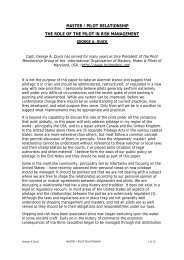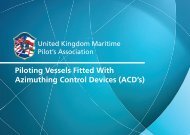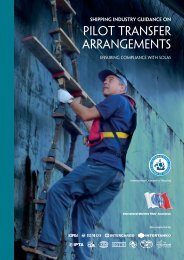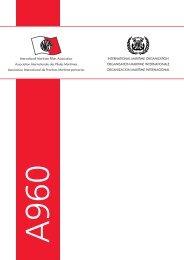The rigging of ladders for pilot transfer - International Maritime Pilots ...
The rigging of ladders for pilot transfer - International Maritime Pilots ...
The rigging of ladders for pilot transfer - International Maritime Pilots ...
Create successful ePaper yourself
Turn your PDF publications into a flip-book with our unique Google optimized e-Paper software.
Shipping industry guidance<br />
on<br />
<strong>The</strong><br />
<strong>rigging</strong> <strong>of</strong><br />
<strong>ladders</strong><br />
<strong>for</strong> <strong>pilot</strong> <strong>transfer</strong><br />
Ensuring compliance with<br />
SOLAS<br />
<strong>International</strong> <strong>Maritime</strong> <strong>Pilots</strong>’ Association<br />
<strong>International</strong> Chamber <strong>of</strong> Shipping<br />
<strong>International</strong> Shipping Federation<br />
Also supported by:<br />
Oil Companies <strong>International</strong><br />
Marine Forum<br />
Society <strong>of</strong> <strong>International</strong><br />
Gas Tanker and<br />
Terminal Operators
Vessel with defects<br />
in the boarding<br />
arrangements
Shipping industry guidance<br />
on<br />
<strong>The</strong><br />
<strong>rigging</strong> <strong>of</strong><br />
<strong>ladders</strong><br />
<strong>for</strong> <strong>pilot</strong> <strong>transfer</strong><br />
Ensuring compliance with<br />
SOLAS<br />
<strong>The</strong> following guidance has been produced by the<br />
<strong>International</strong> <strong>Maritime</strong> <strong>Pilots</strong>’ Association (IMPA) in<br />
collaboration with the <strong>International</strong> Chamber <strong>of</strong> Shipping<br />
(ICS) and the <strong>International</strong> Shipping Federation (ISF).<br />
General<br />
<strong>Pilots</strong> come aboard ship to assist the crew during the most<br />
critical and potentially hazardous phases <strong>of</strong> a voyage.<br />
Qualified <strong>pilot</strong>s possess exceptional local knowledge and<br />
have the necessary ship-handling skills to assist the safe<br />
arrival and departure <strong>of</strong> vessels.<br />
Normally, <strong>pilot</strong>s board and disembark using a traditional<br />
rope ladder from and to a <strong>pilot</strong> boat. However, this can be a<br />
very dangerous procedure if those involved do not adhere to<br />
<strong>International</strong> <strong>Maritime</strong> Organization (IMO) standards or fail to<br />
practise acceptable seamanship skills.<br />
Most regrettably, in recent years, several <strong>pilot</strong>s have died<br />
as a result <strong>of</strong> accidents while boarding/disembarking from<br />
ships, and many more have been seriously injured.<br />
Furthermore, deficiencies with regard to boarding<br />
arrangements and unsafe <strong>rigging</strong> <strong>of</strong> <strong>pilot</strong> <strong>ladders</strong> continue to<br />
be detected during port state control inspections, resulting in<br />
delays and financial penalties <strong>for</strong> the ship operator.<br />
Nevertheless, <strong>pilot</strong> <strong>ladders</strong> remain the most<br />
safe and efficient way to board ships at sea<br />
and there is usually no alternative, except<br />
on occasions when a helicopter is used.<br />
<strong>The</strong> following guidance is intended to<br />
remind seafarers and shipping companies<br />
<strong>of</strong> the vital importance <strong>of</strong> adhering to<br />
the rules and established procedures<br />
concerning the provision <strong>of</strong> safe boarding<br />
arrangements <strong>for</strong> <strong>pilot</strong>s.<br />
Ensuring safe <strong>rigging</strong><br />
<strong>for</strong> <strong>pilot</strong>s<br />
<strong>The</strong> IMO Convention <strong>for</strong> Safety <strong>of</strong> Life at<br />
Sea (SOLAS Chapter V, Regulation 23)<br />
sets out the principal requirements <strong>for</strong> the<br />
<strong>rigging</strong> <strong>of</strong> <strong>pilot</strong> <strong>ladders</strong>.<br />
<strong>The</strong>se provisions are set out in the<br />
diagram contained in this brochure.<br />
This diagram can be downloaded at<br />
www.impahq.org (on the home page, click<br />
on ‘Downloads’). It is also reproduced in<br />
the ICS Bridge Procedures Guide.<br />
<strong>The</strong>re is a further detailed technical<br />
specification <strong>for</strong> <strong>pilot</strong> <strong>ladders</strong> in IMO<br />
Resolution A.889(21). Shipping<br />
companies have a legal obligation to<br />
provide a con<strong>for</strong>ming ladder and shipborne<br />
fittings. If seafarers are uncertain<br />
about any <strong>of</strong> the requirements, they<br />
should always ask their supervising <strong>of</strong>ficer<br />
<strong>for</strong> advice.<br />
<strong>The</strong> two major causes <strong>of</strong> accidents are<br />
defects in the ladder treads or sideropes<br />
(see diagram) or a lack <strong>of</strong> proper<br />
attachment <strong>of</strong> the ladder to the vessel.<br />
Seafarers should always check the<br />
condition <strong>of</strong> the ladder be<strong>for</strong>e it is rigged<br />
and also ensure it is secure to the ship.<br />
Whilst this is done, seafarers should<br />
always take care <strong>of</strong> their own safety,<br />
wearing a life jacket (and a life-line if<br />
appropriate).<br />
Management issues<br />
Shipping companies should ensure that:<br />
• Ladders are SOLAS compliant<br />
• <strong>The</strong> inspection regime and records are<br />
adequate<br />
• Replacement <strong>ladders</strong> are quickly and<br />
readily available, preferably by carriage<br />
<strong>of</strong> at least one spare ladder<br />
• Seafarers involved receive the<br />
necessary training and have a full<br />
understanding <strong>of</strong> the requirements.<br />
IMPA is able to provide an advice<br />
document <strong>for</strong> new construction designs.<br />
On board issues<br />
<strong>The</strong> Master and <strong>of</strong>ficers should:<br />
• Closely supervise the <strong>rigging</strong> <strong>of</strong> <strong>pilot</strong><br />
<strong>ladders</strong><br />
• Closely observe the shipping/landing<br />
<strong>of</strong> <strong>pilot</strong>s from <strong>ladders</strong> ensuring that<br />
SOLAS requirements are met<br />
• Maintain a lee until the <strong>pilot</strong> vessel is<br />
well clear.<br />
Summary<br />
<strong>Pilots</strong> have the right to decline to board<br />
vessels <strong>of</strong>fering defective <strong>ladders</strong>, which<br />
can result in serious delay. <strong>Pilots</strong> are<br />
also entitled to report defects in boarding<br />
<strong>ladders</strong> to port state control authorities,<br />
which could lead to a full PSC inspection<br />
with the risk <strong>of</strong> delay and financial<br />
penalties.<br />
A <strong>pilot</strong> who has climbed a sound ladder,<br />
well rigged, and attended by an <strong>of</strong>ficer<br />
and a deck party will be in the right frame<br />
<strong>of</strong> mind to give his best attention to the<br />
safety <strong>of</strong> the vessel.
Shipping industry<br />
guidance on the<br />
<strong>rigging</strong> <strong>of</strong> <strong>ladders</strong><br />
<strong>for</strong> <strong>pilot</strong> <strong>transfer</strong><br />
Published by:<br />
<strong>Maritime</strong> <strong>International</strong> Secretariat<br />
Services Limited<br />
12 Carthusian Street<br />
London EC1M 6EZ<br />
Tel +44 20 7417 8844<br />
Fax +44 20 7417 8877<br />
publications@marisec.org<br />
www.marisec.org<br />
First edition 2008<br />
An electronic version <strong>of</strong> this leaflet is<br />
available at:<br />
www.marisec.org/<strong>pilot</strong><strong>ladders</strong><br />
<strong>International</strong> <strong>Maritime</strong> <strong>Pilots</strong>’ Association<br />
<strong>International</strong> Chamber <strong>of</strong> Shipping<br />
<strong>International</strong> Shipping Federation<br />
Also supported by:<br />
<strong>The</strong>se guidelines have been developed using the<br />
best in<strong>for</strong>mation available, but they are intended<br />
<strong>for</strong> guidance only, to be followed at the users’<br />
own risk. No responsibility is accepted by any<br />
firm, corporation or organisation who or which has<br />
been in any way concerned with the furnishing <strong>of</strong><br />
data, the compilation, publication or authorised<br />
translation, supply or sale <strong>of</strong> this guidance, <strong>for</strong><br />
the accuracy <strong>of</strong> any in<strong>for</strong>mation or advice given<br />
herein, or any omission herefrom or consequences<br />
whatsoever resulting directly or indirectly from use<br />
<strong>of</strong> these guidelines or from compliance with or<br />
adoption <strong>of</strong> guidance contained therein.<br />
Oil Companies <strong>International</strong><br />
Marine Forum<br />
Society <strong>of</strong> <strong>International</strong><br />
Gas Tanker and<br />
Terminal Operators








